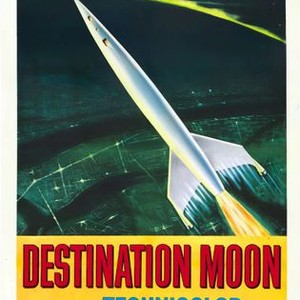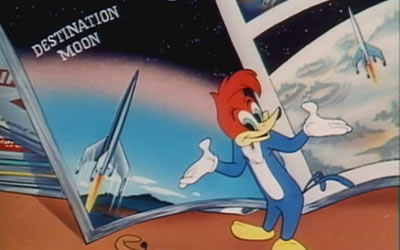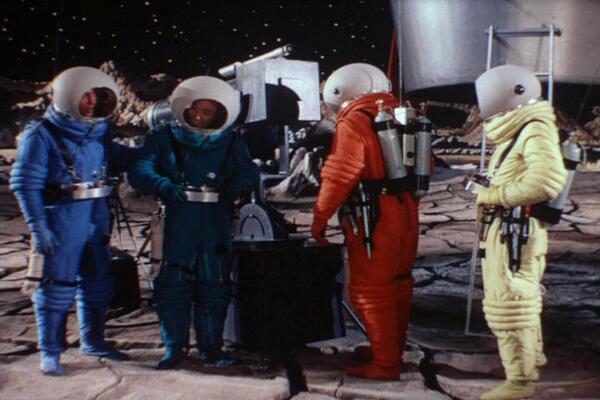A deuce documentary approach to the first flight to the moon, and back from producer George Pal, who went to great lengths, consulting Willy Ley, to get the science right, as it was then understood, and to get a major studio to release it for an A movie audience. He succeeded with the former but not the latter. The film was so eagerly anticipated that it spawned several quickies to ride the coattails of its publicity. e.g., ‘Flight to Mars’ (1950) and ‘Rocket X M’ (1950) and others.

Lobby card
Space flight in 1950 was kid stuff, Buck Rogers, Captain Z-ro, Space Cadets, Flash Gordon, and Rocky Rocket, not for adults. The ‘New York Times’ reviewer, Bosley Crowther (1905-1981), agreed in a condescending, snide, and asinine review at the time. Crowther offered his own scientific advice, according to which space flight was i m p o s s i b l e. Period. He explained that the acceleration necessary to leave the Earth’s gravity could not be achieved. Never. Crowther also garbled the concept of ‘free orbit.’ No doubt he would be an Anti-Vaxxer climate denier today with that grasp of physics. Good thing he did not have to review ‘Fantasia’ (1940).
The film follows the preparation, launch, landing, and return of four astronauts from the United States in the hard Korean winter of the Cold War. The word ‘astronaut’ is not used, rather they are spacemen. There are obstacles aplenty. Test rockets that check out perfectly then fail on launch. How can that be? Sabotage by ‘them.’ Get it? The Reds left the beds and are now under the launch pads.
Indeed ‘they’ have infiltrated the government so that it cannot develop the moon missiles. Sounds like the party line from the House Un-American Activities Committee via the typewriter of Robert Heinlein whose story is the root of this film.
Yet it is imperative to get to the moon to prevent ‘them’ from getting there and using it as a missile platform. Something that ‘we’ would never do.
It is up to all those defence contractors to build the rocket. One of their number convenes a meeting and puts the proposal. Time to put up or shut up! After some hemming and hawing they agree. (As if!) A good thing, because if they did not, then no movie and no paycheque for Heinlein.

Woody explains space flight to the magnates.
Four aged men, none of them a pilot, one a general who evidently is free to roam the cosmos, two technicians who developed the engine, and the red shirt comic relief are the elite crew. In contrast to many other genre films of the time, there is no woman on board to be the butt of stupid remarks. In this outing the stupid remarks come from the comic relief. His naive and querulous remarks allow the three smartypantses to explain the science of moon flight to him. Also absent are tensions among the crew whose members work well together. Space flight is difficult enough, leaving no time for bickering and acrimony and that makes a refreshing change of clichés.
The gravitational force on takeoff, weightlessness, space sickness, free orbit, the starry cosmos. extra-vehicular activity are all there, and well done. The desolate moonscape is very nicely done, though the cracks on the studio floor imply it was once wet like a dry river bed. Hmm.
There are moments of drama during the EVA (see above, Mortimer). The landing is rough and consumes a great deal of fuel, compromising the return flight. Before facing that, the scientists in bright coloured, high visibility space suits claim the moon for the United States. oh, and all mankind. That’ll fix ‘them.’ ‘They’ would not dare set foot up there now!

High visibility space suits, which were later re-used in other films. Check out the floor cracks.
At the approach of the launch window for the return flight the crew must shed weight from the ship. A lot. More. Yes, as predicted, though they rip out just about all the props there is still too much weight. By coincidence the excess weight matches that of the red shirt comic relief. Gulp!
The three big brains sit around trying to out noble each other by volunteering to stay behind for certain death. The industrialist, the AWOL general, and the engineer with the deep voice compete in declaring themselves useless. [Pause.] While they are listening to themselves, it’s a no-brainer and the comic relief jumps ship to sacrifice himself. ‘Good,’ I said, ‘no more stupid questions.’ But ‘we’ do not leave anyone behind (as ‘they’ would, is implied.)
But wait, at that moment the industrialist sees a way to shed more weight, and it is an ingenious idea, and can only work if the comic relief returns, which he does.
Whew! The four of them make it back to a return of heroes. A few bold individuals can do what the government cannot. Was this Ayn Rand’s favourite movie? ‘The End … of the beginning,’ says the closing title. Six years later Sputnik went beep beep in Bosley Crowther’s ear. George Pal was way ahead of the curve unlike the ‘New York Times’ reviewer whose mea culpa could not be found on the interweb.
Pal could not convince a major studio to make the film so he created a shelf-company and did it himself as an independent production. The can-do spirit of private enterprise did not apply to the big studios. He did negotiate release through Allied Artists.
Skip to content
